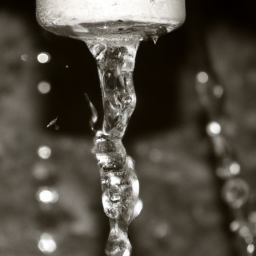Get ready to learn all about the fascinating process of reverse osmosis water filtration! With the help of a semi-permeable membrane, this water purification system removes impurities, contaminants, and larger particles to produce clear, purified water. The process involves pre-filtration to trap particles and remove chemicals, reverse osmosis to separate water molecules from contaminants, post-filtration to polish the water, storage to ensure availability, waste disposal, and finally, faucet delivery for your convenience. By understanding how a reverse osmosis water filter works, you’ll gain insight into its effectiveness in providing you with the highest level of purified water. So let’s dive in and explore this incredible process together!
Pre-filtration
Before the water undergoes the reverse osmosis process, it goes through a crucial pre-filtration stage. This stage involves two components: a sediment filter and a carbon filter.
The sediment filter plays a vital role in removing larger particles such as sand and silt from the water. By trapping these particles, the sediment filter ensures that the water entering the reverse osmosis membrane is free from any debris that could potentially clog or damage the membrane.
The carbon filter, on the other hand, focuses on eliminating chlorine and other chemicals from the water. Chlorine and other chemicals can be harmful to the reverse osmosis membrane, so it is essential to remove them before the water enters the next stage. The carbon filter effectively adsorbs these contaminants, ensuring that the water is clean and ready for the reverse osmosis process.
Reverse Osmosis
The reverse osmosis stage is the central component of the water filtration process. During this stage, the pre-filtered water is forced through a semi-permeable membrane under pressure. This membrane is incredibly fine, allowing only water molecules to pass through while effectively trapping contaminants such as salts, heavy metals, bacteria, and many others.
The principle behind reverse osmosis is that the water molecules are smaller than most contaminants, allowing them to pass through the membrane while leaving the impurities behind. As a result, the water that passes through the membrane is significantly cleaner and purer.
Reverse osmosis is an incredibly effective filtration method, capable of removing up to 99% of contaminants from the water. Its ability to eliminate harmful substances makes it one of the most reliable water purification systems available.
Post-filtration
After undergoing the reverse osmosis process, the water goes through an additional post-filtration stage. This stage usually involves another carbon filter.
The purpose of the post-filtration step is to further refine the water and ensure that any remaining taste or odor is eliminated. The carbon filter used in this stage is highly effective at removing any lingering impurities, ensuring that the water is not only purified but also pleasant to taste.
Storage
Due to the relatively slow nature of the reverse osmosis filtration process, a storage tank is an essential component of the system. After the water has passed through the pre-filtration, reverse osmosis, and post-filtration stages, it is stored in a tank. This ensures that purified water is available on demand.
The storage tank also helps to maintain water pressure, allowing for convenient faucet delivery whenever you need purified water. Without the storage tank, the reverse osmosis system would need to operate continuously to supply water, which would be both inefficient and impractical.
Drain or Waste
During the reverse osmosis process, not all of the water undergoes purification. For every gallon of purified water produced, a certain amount of water containing the concentrated contaminants is flushed away. This water, known as the brine or waste water, is directed to a drain or waste line.
While it may seem wasteful to discard water in this manner, it is an essential part of the reverse osmosis process. Removing the concentrated contaminants keeps the reverse osmosis membrane clean and functioning optimally. Additionally, newer reverse osmosis systems are designed to be more water-efficient, minimizing the amount of waste water produced.
Faucet Delivery
When you turn on the dedicated faucet for the reverse osmosis system, the purified water is drawn from the storage tank. The faucet ensures that you can conveniently access the purified water whenever you need it.
The faucet delivery system is designed to provide a steady flow of purified water, allowing you to use it for drinking, cooking, or any other household activities. The purified water from the storage tank is readily available and ensures that you have access to clean and safe water whenever you need it.
Summary
In summary, the reverse osmosis water filter is an effective and reliable method of purifying water. It utilizes multiple stages of filtration to remove impurities and contaminants, producing clear and purified water. The pre-filtration stage eliminates larger particles and chemicals, ensuring the reverse osmosis membrane remains unobstructed and undamaged. The reverse osmosis process itself forces water through a semi-permeable membrane, effectively trapping contaminants while allowing water molecules to pass through. The post-filtration stage further refines the water, removing any remaining taste or odor. The purified water is then stored in a tank for convenient access and delivered through a dedicated faucet. The reverse osmosis water filter system provides a reliable source of clean and safe water for all your household needs.

